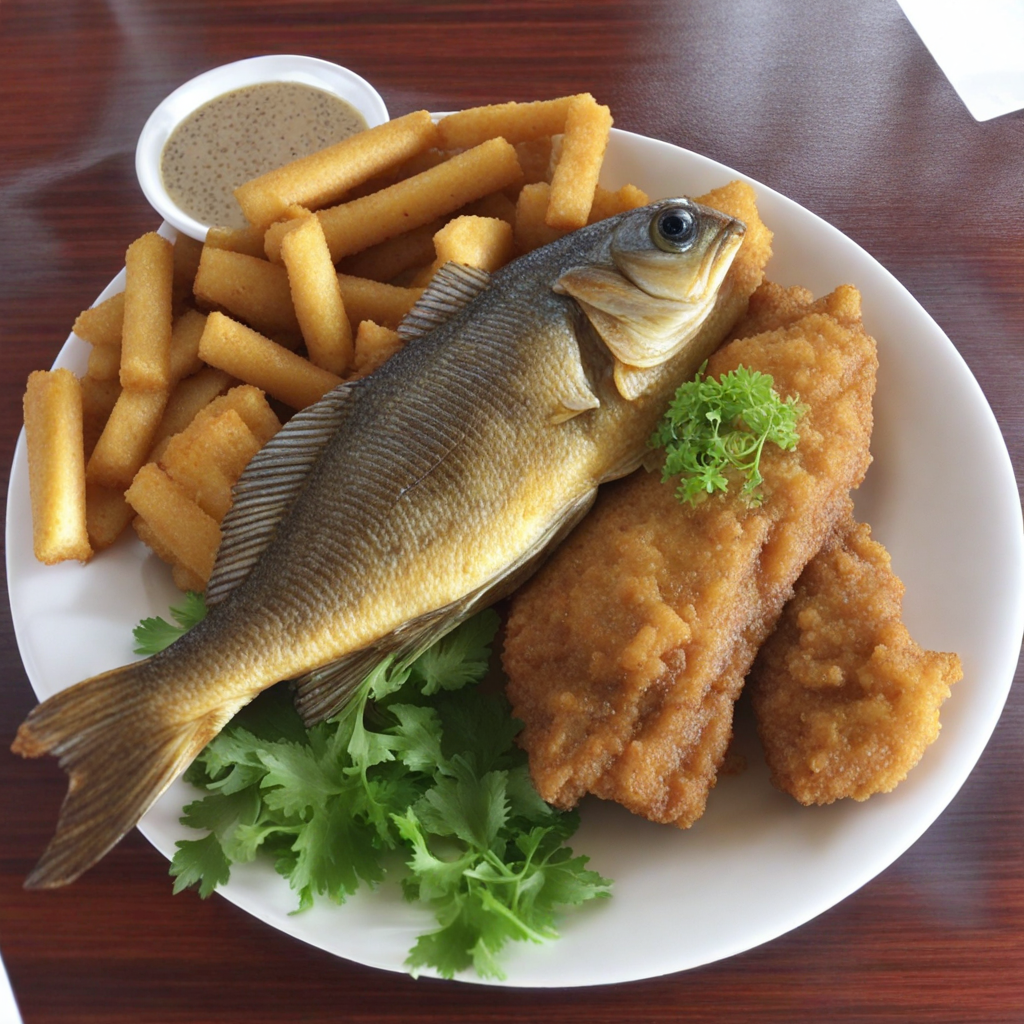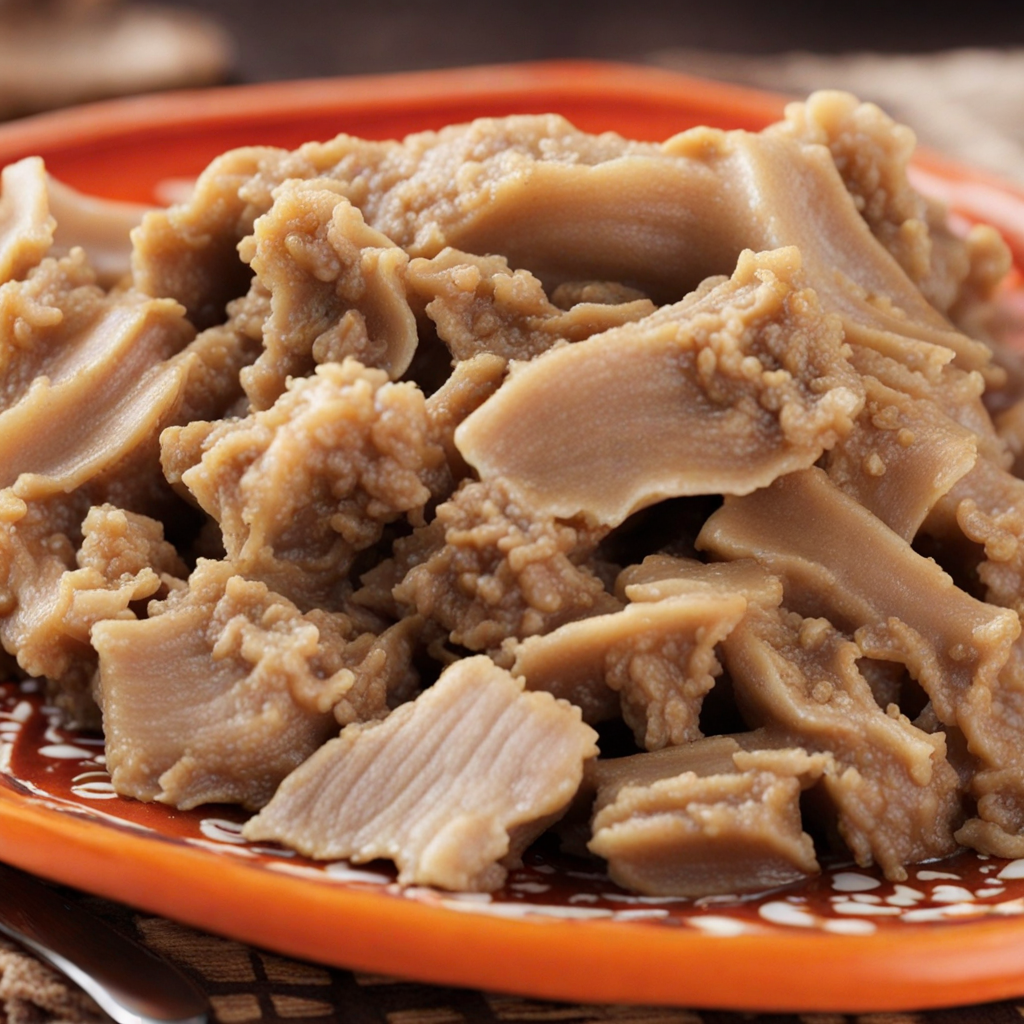Fried Fish
Fried Fish in Botswana is a delightful culinary experience that showcases the country’s rich aquatic bounty, particularly from the Okavango Delta and other local waters. The fish used, often tilapia or catfish, is typically caught fresh and then marinated in a blend of local spices, which may include garlic, ginger, and a hint of chili, adding depth and a gentle warmth to the dish. The marination process allows the fish to absorb the vibrant flavors, preparing it for the final cooking stage. Once marinated, the fish is coated in a light dusting of flour or cornmeal, which gives it a crispy exterior when fried. The frying process is crucial; it’s done in hot oil until the outside is golden brown and crunchy, while the inside remains tender and flaky. This contrast in texture is one of the highlights of the dish, making each bite a satisfying experience. Fried Fish is often served with a side of pap, a traditional maize porridge, or a fresh salad made from local vegetables, enhancing the meal with additional flavors and textures. Accompanying the Fried Fish, you might find a tangy lemon or a spicy chili sauce that elevates the dish further, allowing diners to customize their experience. The simplicity of the ingredients, combined with traditional cooking techniques, makes Fried Fish a beloved staple in Botswana. It's not just a dish; it’s an invitation to savor the essence of Botswana’s culinary heritage, embodying the warmth and hospitality of the people.
How It Became This Dish
Feshi e e Kwatlhang: A Taste of Botswana’s Culinary Heritage Introduction Feshi e e kwatlhang is a traditional dish from Botswana that encapsulates the essence of the country’s rich cultural heritage and agricultural practices. This dish, which translates to "sour porridge" or "sour meal," is deeply rooted in the customs and traditions of the Tswana people, reflecting their relationship with the land, their resilience in the face of adversity, and their communal way of life. In this exploration, we will delve into the origins of feshi e e kwatlhang, its cultural significance, and its evolution over time. Origins The origins of feshi e e kwatlhang can be traced back to the agrarian practices of the Tswana people, who have inhabited Botswana for centuries. The dish is primarily made from fermented maize or sorghum, staples that have sustained many African communities. The process of fermentation, which is key to developing the sour flavor profile of feshi, has its roots in ancient food preservation techniques. This method not only prolongs the life of the grains but also enhances their nutritional value, making them easier to digest. Historically, the Tswana people cultivated maize and sorghum in the fertile regions of Botswana, taking advantage of seasonal rains. These grains became central to their diet, and the practice of fermenting them evolved over generations. The fermentation process involves soaking the grains in water, allowing natural yeasts and bacteria to develop, which creates a tangy flavor that is characteristic of feshi e e kwatlhang. Cultural Significance Feshi e e kwatlhang is more than just a meal; it holds deep cultural significance for the Tswana people. It is often served during communal gatherings, ceremonies, and celebrations, symbolizing unity and togetherness. The preparation and sharing of this dish create bonds among families and communities, reinforcing social ties that are vital in Tswana culture. In many communities, feshi is not only a culinary staple but also a symbol of heritage and identity. It is commonly associated with traditional rituals and rites of passage, particularly during ceremonies that celebrate marriage, childbirth, or the harvest. The act of preparing feshi is often communal, with women gathering to share stories, songs, and laughter while they work together in the kitchen. This communal spirit captures the essence of Tswana culture, where food is a medium for connection and expression. Moreover, feshi e e kwatlhang serves as a testament to the resilience of the Tswana people. In times of drought or hardship, this dish represents a way to make the most of available resources. The fermentation process allows for the use of grains that might otherwise spoil, demonstrating ingenuity and resourcefulness. It also highlights the importance of sustainability, as traditional practices promote the use of locally sourced ingredients. Development Over Time As Botswana has evolved, so too has the dish of feshi e e kwatlhang. In the past, its preparation was a labor-intensive process that required a deep understanding of fermentation techniques passed down through generations. However, with modernization and urbanization, the methods of preparation have adapted to fit contemporary lifestyles. In urban areas, where traditional food practices may be challenged by busy schedules and changing dietary habits, there has been a shift towards convenience. Pre-packaged fermented maize or sorghum products are now available in markets, allowing individuals to prepare feshi with less time and effort. This shift has sparked a dialogue about the balance between convenience and tradition, as many people express a desire to maintain the authentic flavors and communal aspects of the dish. Despite these changes, many rural communities continue to uphold traditional methods of preparing feshi e e kwatlhang. In these areas, the dish remains a staple food, integral to daily life and cultural practices. Festivals and events celebrating Botswana’s culinary heritage often feature feshi, reinforcing its importance in the national identity. The government and local organizations have also recognized the value of traditional dishes like feshi, promoting them as part of the country’s tourism strategy to highlight Botswana’s rich cultural tapestry. Modern Interpretations In recent years, there has been a resurgence of interest in traditional foods across Africa, with chefs and home cooks alike seeking to revive and innovate upon age-old recipes. Feshi e e kwatlhang has not escaped this wave, as contemporary chefs are experimenting with the classic dish, adding modern twists while preserving its essence. Some chefs have introduced variations of feshi by incorporating other local ingredients, such as wild herbs, vegetables, or proteins. This innovation not only broadens the flavor profile of the dish but also highlights the biodiversity of Botswana’s culinary landscape. Additionally, fusion cuisine has emerged, with influences from other cultures leading to creative interpretations of feshi that appeal to a wider audience. Conclusion Feshi e e kwatlhang is a dish that embodies the history, culture, and resilience of the Tswana people. As it has evolved over time, it has maintained its significance as a communal dish that fosters connections among people. Whether prepared in traditional ways or reimagined in modern kitchens, feshi continues to be a symbol of Botswana’s agricultural heritage and cultural identity. In an age where globalization often threatens traditional culinary practices, feshi e e kwatlhang stands as a testament to the importance of preserving one’s culinary roots. As people around the world seek greater authenticity in their food experiences, dishes like feshi e e kwatlhang serve as a reminder of the power of food to tell stories, build communities, and celebrate heritage. As Botswana moves forward, this cherished dish will undoubtedly remain a vital part of its cultural narrative, connecting past, present, and future generations through the simple act of sharing a meal.
You may like
Discover local flavors from Botswana







